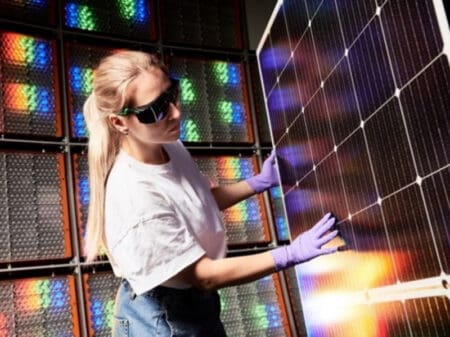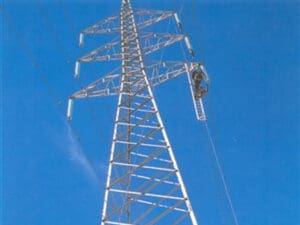
Perovskite is gaining increasing interest for its potential to boost solar PV – if challenges with its use can be overcome.
Graphene is often described as the ‘wonder material’ and it has a name for it but that is for applications such as energy storage.
But another candidate for the moniker is the less high-tech sounding perovskite that is expected to bring the next step change for solar photovoltaics, with new levels of efficiency and cost-effectiveness.
Perovskite, which is named after the Russian mineralogist Lev Perovski following its discovery in Russia’s Ural Mountains in 1839, is a naturally occurring mineral of calcium titanium oxide (CaTiO3).
Have you read?
Tech Talk | Space-based solar energy advances
Harnessing the power of the EU’s Space Programme for renewable energy
Despite being so long known it is only in this century that perovskites, i.e. not only perovskite itself but also other materials with a similar chemical structure that occur both naturally and can be synthesised in the lab, have been found to have a range of unusual physical properties such as superconductivity and ferroelectricity.
This makes them suitable for a range of applications, of which solar cells have emerged as the most prominent, with the potential to offer a low-cost, high-efficiency product – around at least 20% more than that of traditional silicon cells – that could boost the global renewables revolution.
But that potential has also come with challenges, in particular the stability of perovskites to the day-to-day environmental factors to which they must be subject, such as moisture, light and temperature.
No surprise then that the development of perovskites has seen, and is seeing, considerable investment and research interest along with the entry of new startups with the prospect of a major market opportunity.
Commercialising perovskite solar cells
Though they have yet to become fully commercialised, that day is not far off with Oxford PV, a spin-off from the University of Oxford in the UK, at the forefront after over a decade of developing the technology.
Oxford PV, founded in 2010 to advance solar PV but only latterly focussing exclusively on perovskites has pioneered the ‘tandem cell’ approach in which perovskite is added on top of conventional silicon solar cells to enhance their performance while maintaining the standard cell footprint.
In May 2023 Oxford PV recorded a record 28.6% cell conversion efficiency and in January 2024 a record panel efficiency of 25% compared with the averages for standard silicon cells and panels around 22 to 23%.
Moreover, Oxford PV’s theoretical maximum efficiency for its tandem cell approach is more than 40% compared with less than 30% for the standard cells.
“This new world record is a crucial milestone for Oxford PV, proving that our tandem solar cells can deliver record-breaking performance when assembled into solar panels,” said David Ward, CEO of Oxford PV, commenting in the January announcement that it is a first step in what should be a “transformative 2024”.
While R&D is continuing to improve the efficiency of the technology with a roadmap to go well beyond 30%, Oxford PV has reported starting production of its tandem cells at its Brandenburg-an-der-Havel site near Berlin in Germany – an acquisition of a former production site from Bosch Solar.
These are then expected to start coming to the market later in 2024, not directly but through their integration into modules of manufacturers in the market.
At the same time, Oxford PV is searching for a new high-volume manufacturing site with a particular eye on the US, where a subsidiary has been registered.
Perovskites in space
Just as perovskites are expected to become the solar PV product of choice for the next generation rooftop and utility-scale deployments, so too they are being eyed for use in space as an alternative to the go-to gallium arsenide cells.
Solar PV is essential in space for providing on-board power to orbiting satellites and for example the International Space Station. Gallium arsenide cells have become the technology of choice for their high absorption but more importantly, their ability to withstand the harsh space environment.
However, the main challenge with their use is the manufacturing costs primarily resulting from the scarcity of gallium and the more complex manufacturing process.
That is where perovskites are expected to have the potential to come in, because of their simpler manufacturing. Another key benefit is their versatility for diverse applications, from lightweight to bendable solar panels – a key factor for the proposed kilometre-scale satellites proposed to deliver solar energy to the Earth from space.
An understanding of the behaviour of perovskites in space is still ongoing, however.
In the Caltech space-based solar demonstrator which ran for most of 2023, the perovskite cells were found to exhibit marked variability in performance, whereas the low cost manufactured gallium arsenide cells had consistently performed well overall.
An earlier 10-month demonstration on the International Space Station also revealed some unusual properties about their absorption characteristics with varying temperature, with both a ‘self healing’ quality and enhanced light absorption that could make them particularly suitable for long-duration missions.
“A lot of people doubted that these materials could ever be strong enough to deal with the harsh environment of space,” said NASA research engineer Dr Lyndsey McMillon-Brown announcing the findings in May 2023, adding: “Not only do they survive, but in some ways, they thrived.”
With space technology developments often spinning off to Earth-based applications, this is a space to also keep watching.
And if you are involved in the development of perovskites, be sure to keep us updated with your findings.
Jonathan Spencer Jones
Specialist writer
Smart Energy International

Follow me on Linkedin








